Naomi Robbins is a freelance writer with over five year's experience. Her work has offered her a huge variety of opportunities from the chance to write promotional leaflets for a company selling chaise sectional sofas to more exotic opportunities to travel around the world writing about her experiences.
2.29.2012
High Flying Birds – Noel Gallagher
Naomi Robbins is a freelance writer with over five year's experience. Her work has offered her a huge variety of opportunities from the chance to write promotional leaflets for a company selling chaise sectional sofas to more exotic opportunities to travel around the world writing about her experiences.
10 GREAT SONGS: PAULA ABDUL
 Long before she was a judge who helped determine the next big singer on American Idol, Paula Abdul actually made music. (It's true!) The budget "10 great song" series collects some (all?) of her hits from the late '80s and early '90s with 10 Great Songs: Paula Abdul.
Long before she was a judge who helped determine the next big singer on American Idol, Paula Abdul actually made music. (It's true!) The budget "10 great song" series collects some (all?) of her hits from the late '80s and early '90s with 10 Great Songs: Paula Abdul.This compilation is, well, pretty basic. There are six songs from Abdul's 1988 debut album Forever Your Girl and four from the 1991 follow-up Spellbound. (There's nothing here from Abdul's last album, 1995's Head Over Heels.) There are no rarities, remixes, B-sides, lost tracks, or live versions here -- or even the lesser-known songs from the two albums on this collection.
And how do these hits sound over two decades later? About the same as when they were released: pop fluff. The songs here are all about love (except for the relentlessly optimistic "Promise of a New Day"), either about being in love ("Forever Your Girl," "Knocked Out," the strange "Vibeology") or love gone bad (the man-bashing "Cold Hearted," the wondering "Straight Up"). While Paula Abdul isn't a bad singer, her voice is far from exceptional; and the songs are pretty much routine upbeat pop or slower ballads. The songs are mixed up rather than presented in the original albums' release date, but there's no musical or lyrical development between the albums: They all sound like they could have been made at the same time. This may be the best of Paula Abdul -- certainly her most popular -- but the "great" in this compliation's is somewhat ironic.
10 Great Songs: Paula Abdul is a simple, straightforward presentation of Abdul's hits. This collection demonstrates what made Paula Abdul so radio friendly: extremely simple lyrics, a perky voice, and upbeat pop songs mixed with slower ballads. Decades later, it makes some sort of sense that she would help choose the American Idol winner - who's expected to be more popular than necessarily good.
Overall grade: C-
Reviewed by James Lynch
2.28.2012
Kagero, Japanese Gypsy Rock (CDBY, 2009)

Every January I go to Golden Festival, a massive world music party that runs well into the morning. The music at the Festival is primarily Balkan in flavor, but every year I try to catch one or two acts that break from the usual mold. This year, the swingy band with the Japanese singer certainly qualified.
Fronted by singer/guitarist Kaz, Kagero actually hail from Brooklyn. Their one album, released in 2009, is called Japanese Gypsy Rock. While there is a jazzy influence to their sound, the album title otherwise describes them pretty well. The arrangements are generally dominated by Kaz's acoustic guitar, but fiddler J. W. (also of Japanese descent) plays with a gypsy style reminiscent of Stephane Grapelli, and bassist Rob provides solid support. Lyrically, the songs on Japanese Gypsy Rock cover a series of romantic adventures and misadventures. Kaz is like a one-man UN when it comes to women, as Latin America ("My Little Bonita") China ("Shanghai Calls Me"), and Turkey ("Mermaid from Istanbul") are all explicitly represented here. Kaz's lyrics are almost always tongue-in-cheek, with some flashes of genuine inspiration like on "Say No Adieu": "Every little story that makes you feel sorry though it's been a thorn in your flesh. She does not end it no matter how you bend it though she knows that cogs don't quite mesh."
Kagero are witty, eclectic, and best of all, fun. I hope they get another recording out soon, but Japanese Gypsy Rock will do just fine in the meantime. They are even better live than on record, so if you can get to Brooklyn or Manhattan they're definitely worth catching.
Overall grade: B+
reviewed by Scott
A live performance of "My Daddy Is a Thief"
2.26.2012
WANDERLUST
 George (Paul Rudd) and Linda (Jennifer Aniston) are a fairly typical New York married couple who run into horrible luck: Right after buying a "micro-loft" ("It's a studio apartment!"), George's job is shut down by the F.B.I. and Linda's documentary is rejected by HBO. And the real estate agent who pushed them to buy their micro-loft tells them it's already worth far less than what they paid for it. So they head to Atlanta, where George can get a job working for his truly obnoxious brother Rick (Ken Marino). On the way to Rick's, George and Linda wind up at a hippie commune ("It's not a commune. It's an intentional community") called Elysium, where the odd-but-fun people share everything and live with nature. After leaving, George gets sick of his brother pretty quickly, so he and Linda decide to go live at Elysium.
George (Paul Rudd) and Linda (Jennifer Aniston) are a fairly typical New York married couple who run into horrible luck: Right after buying a "micro-loft" ("It's a studio apartment!"), George's job is shut down by the F.B.I. and Linda's documentary is rejected by HBO. And the real estate agent who pushed them to buy their micro-loft tells them it's already worth far less than what they paid for it. So they head to Atlanta, where George can get a job working for his truly obnoxious brother Rick (Ken Marino). On the way to Rick's, George and Linda wind up at a hippie commune ("It's not a commune. It's an intentional community") called Elysium, where the odd-but-fun people share everything and live with nature. After leaving, George gets sick of his brother pretty quickly, so he and Linda decide to go live at Elysium. Unfortunately, George gets pretty tired of Elysium pretty fast, from the lack of any doors or privacy (as shown in the picture below) to the vegan lifestyle to the nudist author (Joe Lo Trugglio) who's always reading George parts of his novel. It doesn't help that Seth (Justin Theroux), the de facto leader of the commune, seems to be showing up George every chance he gets. And to make things yet worse, Linda loves it there! Then there's the issue of free love, which seesm fine for Linda and Seth but not for George and the beautiful Eva (Malin Ackerman). And then there's the evil corporation out to steal the commune's land, the burned-out hippie (Alan Alda) who can't find the deed, and lots of oddball characters and gross-out jokes.
Unfortunately, George gets pretty tired of Elysium pretty fast, from the lack of any doors or privacy (as shown in the picture below) to the vegan lifestyle to the nudist author (Joe Lo Trugglio) who's always reading George parts of his novel. It doesn't help that Seth (Justin Theroux), the de facto leader of the commune, seems to be showing up George every chance he gets. And to make things yet worse, Linda loves it there! Then there's the issue of free love, which seesm fine for Linda and Seth but not for George and the beautiful Eva (Malin Ackerman). And then there's the evil corporation out to steal the commune's land, the burned-out hippie (Alan Alda) who can't find the deed, and lots of oddball characters and gross-out jokes.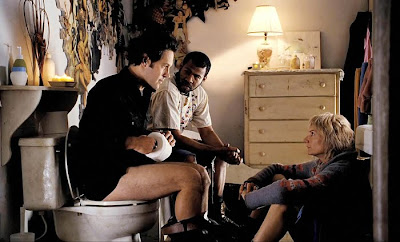 Wanderlust was written by Ken Marino and David Wain, who both have substantial experience with sketch and improvised comedy -- and it shows. The most interesting thing about this movie is matching the actors with their previous sketch/improv shows (from The State to Key and Peele to Mad TV; there's even a talk show hosted by the three stars of Stella). Unfortunately, the movie itself feels oddly artificial, like an excuse for little comedy bits instead of any coherence or development. Most of the humor is poking fun at the nice weirdos in the commune, and it's very lowbrow humor -- from numerous dick jokes to Rudd's painful delivery of "good" seduction lines in a mirror. Most of the actors here have done pretty good work before, but Wanderlust feels like its title: too content to wander aimlessly than to make anything really coherent or good. This movie has some funny moments, but the whole movie is far less than the sum of its cast.
Wanderlust was written by Ken Marino and David Wain, who both have substantial experience with sketch and improvised comedy -- and it shows. The most interesting thing about this movie is matching the actors with their previous sketch/improv shows (from The State to Key and Peele to Mad TV; there's even a talk show hosted by the three stars of Stella). Unfortunately, the movie itself feels oddly artificial, like an excuse for little comedy bits instead of any coherence or development. Most of the humor is poking fun at the nice weirdos in the commune, and it's very lowbrow humor -- from numerous dick jokes to Rudd's painful delivery of "good" seduction lines in a mirror. Most of the actors here have done pretty good work before, but Wanderlust feels like its title: too content to wander aimlessly than to make anything really coherent or good. This movie has some funny moments, but the whole movie is far less than the sum of its cast.2.23.2012
SMALL WORLD: BE NOT AFRAID...
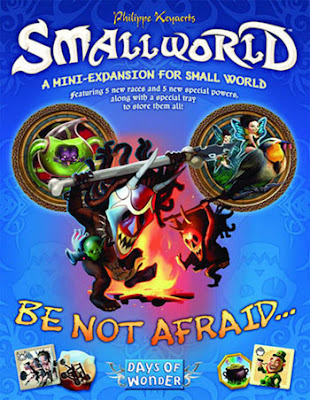 Be Not Afraid... provides players with five new races (Barbarians, Homunculi, Leprechauns, Pixies, Pygmies) and five new special powers (Barricade, Catapult, Corrupt, Imperial, Mercenary) to be used with those in the original game. These new races and powers aren't overly powerful, making players drooling over them whenever they become available, but they do provide new and interesting strategies. For example, Corrupt makes an opponent give you a coin whenever they conquer one of your regions, which is a great deterrent to an opponent.
Be Not Afraid... provides players with five new races (Barbarians, Homunculi, Leprechauns, Pixies, Pygmies) and five new special powers (Barricade, Catapult, Corrupt, Imperial, Mercenary) to be used with those in the original game. These new races and powers aren't overly powerful, making players drooling over them whenever they become available, but they do provide new and interesting strategies. For example, Corrupt makes an opponent give you a coin whenever they conquer one of your regions, which is a great deterrent to an opponent. Imperial gives you a bonus for every region over 3, while Barricade gives you a bonus if you have 4 or less regions. Pixies are quite numerous but can only have 1 in each region at the end of their turn, making them great for attacking but vulnerable to being attacked. And I love the Leprechaun ability: They can put a pot of gold in any/all regions they occupy and score 1 coin for each one they still have at the end of their next turn -- but if an opponent conquers that region, the opponent gets the gold and coin!
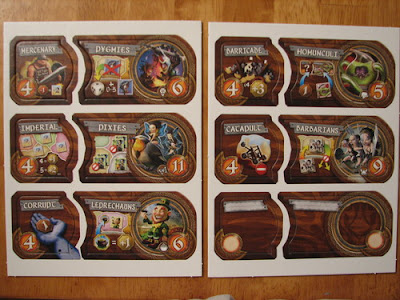 Be Not Afraid... also provides something very useful: a storage tray. This plastic tray holds not only the new races and powers for this expansion, but also has room for other expansions as well! (Mine currently has all the races and special powers from Be Not Afraid... , Cursed! and Grand Dames.) While the cynical may see this as a way to encourage players to buy more expansions, I see it as a welcome touch of convenience, giving players not just new races and powers, but also a convenient place to store them -- something many expansions neglect to provide.
Be Not Afraid... also provides something very useful: a storage tray. This plastic tray holds not only the new races and powers for this expansion, but also has room for other expansions as well! (Mine currently has all the races and special powers from Be Not Afraid... , Cursed! and Grand Dames.) While the cynical may see this as a way to encourage players to buy more expansions, I see it as a welcome touch of convenience, giving players not just new races and powers, but also a convenient place to store them -- something many expansions neglect to provide.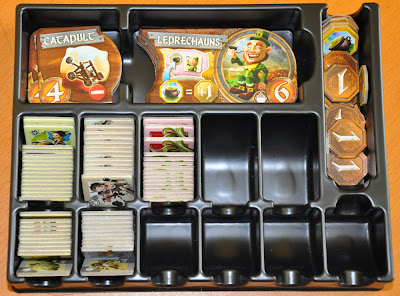 Be Not Afraid... continues the great mystical warring races and powers from the original Small World, offering players more options without tipping the balance in the new additions' favor. It provides new strategic possibilities, fun art -- and a place to put your new stuff.
Be Not Afraid... continues the great mystical warring races and powers from the original Small World, offering players more options without tipping the balance in the new additions' favor. It provides new strategic possibilities, fun art -- and a place to put your new stuff.2.20.2012
Mike Doughty, Yes and Also Yes (SNACK BAR Records, 2011)

The appealingly enigmatic Mike Doughty cranks out albums at a fairly steady clip. This can be a mixed blessing, of course, as his output is notoriously uneven. Then again, if he wasn't at least interesting, I wouldn't keep checking in on his latest efforts. His new album Yes and Also Yes, released this past summer, is a tad more upbeat and plugged in than his usual work. Once again, though, Doughty manages to be both compelling and confounding.
Doughty generally has a very distinctive style of folk rock, driven primarily by his acoustic guitar. About half of Yes and Also Yes follows that style, but Doughty goes electric on a few songs and adds some programming as well, most obviously on "The Huffer and the Cutter." As usual, though, whether or not you like Yes and Also Yes depends on how much you like Doughty's stream of consciousness lyrics and can tolerate the inconsistency that often comes with it. Sometimes the surrealism works brilliantly, like on the punkishly short "Have At It." Other times, like on "Makelosa Mann," you're left shaking your head. Overall, there's a healthy amount of quality here. "Na Na Nothing" is a solid opener, "Holiday (What Do You Want?)" is a very nice duet with Roseanne Cash, and "Weird Summer" is a prescient look at the political attitude currently gripping Doughty's adopted home of New York City.
He's up, he's down, and he's equal parts impressive and frustrating, but Mike Doughty is never dull. Like most of his other albums, Yes and Also Yes hits the mark often enough to justify a few listens.
Overall grade: B
reviewed by Scott
"Na Na Nothing"
Amy LaVere, Stranger Me (Archer Records, 2011)

Singer, bassist, and occasional actress Amy LaVere has not had much luck with men. At least, that's the impression you get from her third album, Stranger Me, which came out this past year. Starting with the opener "Damn Love Song," Stranger Me goes from one angst-ridden song about breaking up or escaping to another. You may wind up saying "OK, I get it already" about halfway through the album, but there are at least a few worthy songs on here.
Actually, the biggest selling point of Stranger Me is the strong collective musicianship of LaVere and her supporting cast. David Cousar (guitar), Paul Taylor (drums), and Rick Steff (keyboards) are solid throughout. In particular, Cousar's simple yet very effective 12-string riff on "Damn Love Song" the standout track on the album. The catch is that LaVere has too gentle a voice to match the angst in her lyrics. She appears to have mastered the art of writing an angry breakup song, but she can't always sing it in a way that makes the listener feel what she's feeling.
The album also suffers from its pacing. The songs slow down after the jazzy "A Great Divide," and don't really pick up after that. The quality on Stranger Me is very front-loaded as a result. Having said that, a few songs earn multiple listens. Amy LaVere does have some talent, and while I wouldn't call this a great record I do think she has room to grow from here.
Overall grade: B-
reviewed by Scott
A live performance of "Damn Love Song"
2.19.2012
DAWN OF ZOMBIE HAIKU
 With the surging popularity of the zombie genre, the undead have gone from horror and social commentary to comedy as well. With Dawn of Zombie Haiku, the second zombie poetry book from Ryan Mecum, we get a blend of horror, romance, sadness, and very violent humor -- all in haiku form, naturally.
With the surging popularity of the zombie genre, the undead have gone from horror and social commentary to comedy as well. With Dawn of Zombie Haiku, the second zombie poetry book from Ryan Mecum, we get a blend of horror, romance, sadness, and very violent humor -- all in haiku form, naturally.The narrator of Dawn of Zombie Haiku is Dawn, a fairly typical 10-year-old New York girl. Dawn lives with her widowed father (and watches zombie movies with him), has a crush on her neighbor Andrew, and keeps a journal where she writes haikus (including haiku versions of famous authors). When the dead come back, Dawn and her father head to Ellis Island for defense; but there's little security there, and soon Dawn winds up as one of the zombies. Yet somehow she keeps writing in her journal, creating haikus about her savage hunger (and zombie haiku versions of classic poems).
If you can get past the idea of a zombie keeping a journal (writing by shambling? pausing to write after feasting on human flesh?), Dawn of Zombie Haiku is a simple, gorily enjoyable take on the zombie theme. While the repeated haikus that make up the whole book become less amusing in and of themselves quickly, the shift from survivor to attacker provides two very different perspectives; and the zombie haiku versions of the classics ("I saw the best minds/ in their degeneration/ tasty, flavorful") provide some nice comic relief. There's a twisted transformation of puppy love to undead love, and less critical examination of the zombie attacks than an observer's perspective -- from both sides of the battle.
If you have a strong stomach, Dawn of Zombie Haiku, like Mecum's original Zombie Haiku, is a funny, twisted, simple, and quick comic take on the undead.
Overall grade: B
Reviewed by James Lynch
2.18.2012
UNDERWORLD AWAKENING Soundtrack
 The movie Underworld: Awakening has a pretty gloomy mood -- from the battling supernatural creatures to the muted blue visual feel -- so it's no surprise that the Underworld: Awakening soundtrack features many goth and downbeat songs. While these songs weren't featured glaringly in the movie (no one "big single" getting lots of radio airplay), they also aren't that distinct on their own.
The movie Underworld: Awakening has a pretty gloomy mood -- from the battling supernatural creatures to the muted blue visual feel -- so it's no surprise that the Underworld: Awakening soundtrack features many goth and downbeat songs. While these songs weren't featured glaringly in the movie (no one "big single" getting lots of radio airplay), they also aren't that distinct on their own.Almost half of the songs on the Underworld: Awakening soundtrack are remixes, while the rest are originals. The remixes are of varying quality -- done well on Evanescence's "Made of Stone" and the Cure's "Apart," but reducing Linkin Park's "Blackout" to mostly screaming -- and they all sound like the typical music you'd hear in an industrial/goth club.
This sameness of the songs here applies to the original songs as well. There's a consistently downbeat theme to most of the songs (as titles like "You Won't See the Light" and "It Rapes All in Its Path" indicate) and the overall effect is that nothing really stands out. Some of the songs on the Underworld: Awakening soundtrack are some better examples of this darker genre of music, but not enough songs stand out from the ones that come before or after the other ones here.
Overall grade: C
Reviewed by James Lynch
2.15.2012
Arch/Matheos, Sympathetic Resonance (Metal Blade Records, 2011)

In the 80s, singer John Arch and guitarist Jim Matheos were the creative nucleus of the progressive metal band Fates Warning. Arch left the group in the late 80s, and with the exception of a two-song EP called A Twist of Fate he has spent most of the last 25 years away from the spotlight. Matheos has continued to lead Fates Warning in the meantime. Despite whatever differences led to the initial split, Arch and Mateos have kept the lines of communication open, and Mateos has made plenty of effort to get Arch back into the studio. The effort finally succeeded with the recording of Sympathetic Resonance, a collaborative effort credited to Arch/Matheos. Most of the current lineup of Fates Warning back them up.
For people familiar with Fates Warning or A Twist of Fate, the musical style on Sympathetic Resonance isn't really new. It does give the target audience what they want, however. The album consists of six songs spanning fifty-four minutes. That obviously means the songs are long, but they are also carefully developed and pieced together riff by riff. The album is almost symphonic in its frequent return to particular musical and lyrical themes. Having been heard so infrequently in the last twenty-five years, Arch's voice necessarily will get most of the attention. Of course, it's also the primary selling point of the record, as their are few singers who can match his range or the genuine power he gives to the high notes he can hit.
Arch's lyrics on Sympathetic Resonance follow a young person trapped in a (real or self-imposed) asylum. Themes of isolation and disillusionment come up often in heavy metal records, to be sure, but when Arch sings that "the world breeds strangers like me," he does so with more than the usual amount of conviction. Arch's disdain for established religion comes through loud and clear, but there are still frequent allusions to religious imagery and addresses to God. These addresses, even when made in anger or frustration, give me the sense that Arch is not so much a militant atheist as somebody who is willing to ask the kind of very difficult and painful questions about the presence of evil in this world that too often get pushed under the rug.
It's not clear if Arch/Matheos will become a lasting partnership; Matheos still has Fates Warning, after all, and Arch has no problem walking away from music when he's not comfortable. For today, though, fans of Arch's voice and his music have plenty of reason to be pleased with Sympathetic Resonance.
Overall grade: B
reviewed by Scott
"Midnight Serenade"
2.12.2012
WIZ-WAR
 Wiz-War lets 2-4 players take on the roles of competing wizards. The players are in a labyrinth of twisting corridors and sealed doors, with their home base in the center of their tile and their two treasures nearby. Every wizard starts with 15 life points and five cards. Each turn is divided into three turns. First, time passes (reducing the duration of temporary spells). Then, a playes can move (three spaces, plus any Energy cards used, around the board or through portals), pick up or drop items and treasures, make one attack (either on a player, or to destroy a wall or door), and cast other spells (from transformations to elemental powers). Finally, a player can discard cards and draw up to two cards (up to seven cards). A player scores one point for each enemy treasure dropped in their home base and one point for each killed opponent.
Wiz-War lets 2-4 players take on the roles of competing wizards. The players are in a labyrinth of twisting corridors and sealed doors, with their home base in the center of their tile and their two treasures nearby. Every wizard starts with 15 life points and five cards. Each turn is divided into three turns. First, time passes (reducing the duration of temporary spells). Then, a playes can move (three spaces, plus any Energy cards used, around the board or through portals), pick up or drop items and treasures, make one attack (either on a player, or to destroy a wall or door), and cast other spells (from transformations to elemental powers). Finally, a player can discard cards and draw up to two cards (up to seven cards). A player scores one point for each enemy treasure dropped in their home base and one point for each killed opponent.
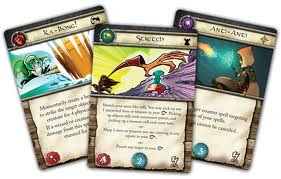 There are several elements that make Wiz-War complex, unpredictable, and exciting. The two paths to victory -- treasure-gathering or total combat -- are equally possible, and a player may switch between the two as opportunities arise during the game. Wiz-War offers players a variety of counter-spells, from damage reduction to "Featherweight" which pushes the target a number of spaces equal to the points of damage they would have taken; so no combat is a sure thing. Since Energize cards can be used to increase speed, the damage of an attack, or the duration of a temporary spell, a player will have to think carefully about how to use these cards.
There are several elements that make Wiz-War complex, unpredictable, and exciting. The two paths to victory -- treasure-gathering or total combat -- are equally possible, and a player may switch between the two as opportunities arise during the game. Wiz-War offers players a variety of counter-spells, from damage reduction to "Featherweight" which pushes the target a number of spaces equal to the points of damage they would have taken; so no combat is a sure thing. Since Energize cards can be used to increase speed, the damage of an attack, or the duration of a temporary spell, a player will have to think carefully about how to use these cards.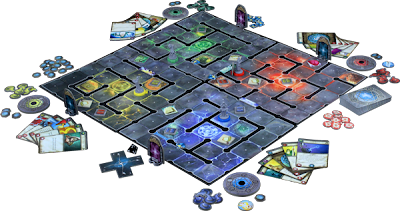 Surprisingly, one of the most challenging elements of Wiz-War is the hand limit. You can only have seven cards, and you can't draw more cards until you go below seven. However, all maintained spells, permanent spells, and items count against your hand limit. So as the game progresses, you'll have to decide what spells and items to get rid of in order to get more cards.
Surprisingly, one of the most challenging elements of Wiz-War is the hand limit. You can only have seven cards, and you can't draw more cards until you go below seven. However, all maintained spells, permanent spells, and items count against your hand limit. So as the game progresses, you'll have to decide what spells and items to get rid of in order to get more cards.In addition to that great gameplay, the production values of Wiz-War are terrific. The cards are bright and clear, often with surprisingly funny artwork (like the giant hammer "Ka-Bong!"). There are pieces for just about everything in the game, from destroyed walls to transformed wizards. My only complaint is that the plastic figures are all gray; but I suppose that was done to keep the cost down and to let players paint them as they want.
Wiz-War is a fantastic blend of strategy, chance, resource management (the resources being spells and items), racing, and fighting. This game looks great, plays great, and has tremendous replay potential. Wiz-War is a definite must for any gamer.
THE BEST OF THE SCORPIONS: THE MILLENNIUM COLLECTION
 When it comes to "stadium rock," the blend of heavy metal and pop that feels designed for hearing in large concerts, one of the most recognizable bands is the Scorpions. Active since the 1970s, they've scored numerous hits, awards, and accolades. The Best of the Scorpions: The Millennium Collection is a greatest hits collection that highlights the band's strength and flaws.
When it comes to "stadium rock," the blend of heavy metal and pop that feels designed for hearing in large concerts, one of the most recognizable bands is the Scorpions. Active since the 1970s, they've scored numerous hits, awards, and accolades. The Best of the Scorpions: The Millennium Collection is a greatest hits collection that highlights the band's strength and flaws.Naturally, The Best of the Scorpions opens with "Rock You Like a Hurricane," their signature song that has appeared everywhere from sporting events to strip clubs to Aqua Teen Hunger Force. From there it's songs celebrating sex ("Tease Me, Please Me"), love ("Believe in Love"), and even politics ("Winds of Change," probably less known now for its America-Soviet peace message than the whistling that opens and closes the song).
The Scorpions know how to rock, and they show a mastery of guitar and drums that elevate their music beyond simply being loud. Lyrics aren't their strong suit, going from overly simple rhymes to overly raunchy to overly pretentious (The wise man said just walk this way/ To the dawn of the light/ The wind will blow into your face/ As the years pass you by") -- a flaw of much heavy metal/stadium rock. With that in mind, The Best of the Scorpions is a good snapshot of the big hair stadium rock of the 1980s -- and a lot of the songs still hold up well for getting the blood pumping.
Overall grade: B-
Reviewed by James Lynch
The Scorpions know how to
2.06.2012
THE ARTIST
 The Artist begins in 1927, when George Valentin (Jean Dujardin) is a silent-movie star in Hollywoodland. George is charismatic, handsome, swooned over by women and adored by the press; he also has a loyal driver named Clifton (James Cromwell) and seems happier with Jack, his Jack Russell Terrier co-star, than with his wife Doris (Penelope Ann Miller). Through a "meet cute" George literally bumps into Peppy Miller (Berenice Bejo), an attractive movie extra. Peppy has a crush on George (most notably in a scene with his jacket), and he seems to like her. He even gives her a beauty mark to make her stand out from other actresses.
The Artist begins in 1927, when George Valentin (Jean Dujardin) is a silent-movie star in Hollywoodland. George is charismatic, handsome, swooned over by women and adored by the press; he also has a loyal driver named Clifton (James Cromwell) and seems happier with Jack, his Jack Russell Terrier co-star, than with his wife Doris (Penelope Ann Miller). Through a "meet cute" George literally bumps into Peppy Miller (Berenice Bejo), an attractive movie extra. Peppy has a crush on George (most notably in a scene with his jacket), and he seems to like her. He even gives her a beauty mark to make her stand out from other actresses.
 We jump ahead to 1929, and Peppy has become the new star in Hollywoodland. Unfortunately for George, studio head Al Zimmer (John Goodman) has decided to stop production on silent films and make only "talkies." George refuses to take part in the new world, so he writes, produces, and directs his next silent movie on his own. But the public likes talkies -- and loves Peppy -- and the movie's failure (plus the stock market crash of 1929) leaves George ruined. And he keeps running into Pepper, as the past and future meet up as one star rises and the other declines.
We jump ahead to 1929, and Peppy has become the new star in Hollywoodland. Unfortunately for George, studio head Al Zimmer (John Goodman) has decided to stop production on silent films and make only "talkies." George refuses to take part in the new world, so he writes, produces, and directs his next silent movie on his own. But the public likes talkies -- and loves Peppy -- and the movie's failure (plus the stock market crash of 1929) leaves George ruined. And he keeps running into Pepper, as the past and future meet up as one star rises and the other declines. I left The Artist feeling charmed, saddened, delighted, and thoroughly impressed. This movie is both a celebration of the world of the movies and a sobering look at how quickly it can abandon its idols. Further, making this movie in the format of a silent movie works very well: Characters may complain about the hammy acting in silent movies, but The Artist has no trouble communicating its message to the audience -- and packing quite an emotional punch. Jean Dujardin is terrific as the lead -- does he insist on artistic integrity, or is he simply too stubborn to adapt to the times? -- and Berenice Bejo is luminous as Peppy, the new generation of star who still keeps a soft spot for George. The Artist truly captures what made -- and makes -- movies magical.
I left The Artist feeling charmed, saddened, delighted, and thoroughly impressed. This movie is both a celebration of the world of the movies and a sobering look at how quickly it can abandon its idols. Further, making this movie in the format of a silent movie works very well: Characters may complain about the hammy acting in silent movies, but The Artist has no trouble communicating its message to the audience -- and packing quite an emotional punch. Jean Dujardin is terrific as the lead -- does he insist on artistic integrity, or is he simply too stubborn to adapt to the times? -- and Berenice Bejo is luminous as Peppy, the new generation of star who still keeps a soft spot for George. The Artist truly captures what made -- and makes -- movies magical.2.05.2012
CHRONICLE
 Andrew Detmer (Dane DeHaan) is a high school senior in Seattle who's decided to film everything in his life -- and it becomes clear very quickly that his life sucks. Painfully shy, at school he's either treated like a freak or as a target by bullies. At home, he takes care of his terminally ill mother (Bo Petersen) while enduring abuse from his alcoholic father (Michael Kelly). The closest thing to a friend Andrew has is his cousin Matt (Alex Russell), a nice-if-pretentious high school senior.
Andrew Detmer (Dane DeHaan) is a high school senior in Seattle who's decided to film everything in his life -- and it becomes clear very quickly that his life sucks. Painfully shy, at school he's either treated like a freak or as a target by bullies. At home, he takes care of his terminally ill mother (Bo Petersen) while enduring abuse from his alcoholic father (Michael Kelly). The closest thing to a friend Andrew has is his cousin Matt (Alex Russell), a nice-if-pretentious high school senior.
After being dragged to a rave, Andrew and Matt are recruited by Steve Montgomery (Michael B. Jordan) -- the popular shoo-in for senior president -- to look into a strange passage in the ground. The three teens go exploring, find a strange glowing blue rock formation -- and then things get weird.
 Whatever was in the cavern has given the three superhuman powers. At first they can move things with their mind; they soon expand those abilities to flying and protection from damage. They use the powers for pranks, for showing off, and for fun. But when Andrew accidentally puts someone in the hospital, they start freaking out. Matt tries to make rules for their powers -- no using them on living things, no using them when angry, no using them in public -- but those rules don't last long. And with Andrew clearly more powerful than the other two, things are looking bad...
Whatever was in the cavern has given the three superhuman powers. At first they can move things with their mind; they soon expand those abilities to flying and protection from damage. They use the powers for pranks, for showing off, and for fun. But when Andrew accidentally puts someone in the hospital, they start freaking out. Matt tries to make rules for their powers -- no using them on living things, no using them when angry, no using them in public -- but those rules don't last long. And with Andrew clearly more powerful than the other two, things are looking bad... Chronicle is an interesting take on what would happen if somehow people in the real world suddenly had fantastic abilities -- and for the first half of the movie, that's exactly what we get. The movie deserves credit for not turning its protagonists into either ultra-noble heroes or selfish, despicable villains; instead, we see that life continues almost as normal for them -- until the harshness of Andrew's world leads to a dire pushback from an angry teen with amazing powers.
Chronicle is an interesting take on what would happen if somehow people in the real world suddenly had fantastic abilities -- and for the first half of the movie, that's exactly what we get. The movie deserves credit for not turning its protagonists into either ultra-noble heroes or selfish, despicable villains; instead, we see that life continues almost as normal for them -- until the harshness of Andrew's world leads to a dire pushback from an angry teen with amazing powers. 2.02.2012
GOOD OMENS by Neil Gaiman and Terry Pratchett
 While some folks like to believe the world will end in 2012, and at least one preacher predicted it would happen (twice) in 2011, back in 1990 fantasy authors Neil Gaiman and Terry Pratchett collaborated on Good Omens, a religious apocalypse as influenced by The Hitchhiker's Guide to the Galaxy and Monty Python as by the Bible.
While some folks like to believe the world will end in 2012, and at least one preacher predicted it would happen (twice) in 2011, back in 1990 fantasy authors Neil Gaiman and Terry Pratchett collaborated on Good Omens, a religious apocalypse as influenced by The Hitchhiker's Guide to the Galaxy and Monty Python as by the Bible.The angel Aziraphale and the demon Crowley have been around humanity since God kicked Adam and Eve out of Eden. The two have a sort of friendly animosity, working for opposite sides but meeting and chatting frequently. And when Crowley recieves the Antichrist, with instructions to swap him out for a regular baby, Aziraphale and Crowley decide they like humanity and don't want it destroyed, so they will work together to keep the child perfectly balanced between good and evil. Unfortunately, the Satanist nuns (yes, you read that right) wind up performing a three-child swap.
Jump ahead eleven years, and Aziraphale and Crowley have been focused on Warlock -- the wrong kid. Meanwhile Adam Young -- the actual Antichrist -- hangs out with his gang of three friends (the Them) and is having his powers manifest themselves. He also gets a pet hellhound that he names Dog.
There's the witch Anathema Device, whose ancestor wrote The Nice and Accurate Prophecies of Agnes Nutter, the only book of 100% accurate predictions of the future. There's the somewhat nerdy witch hunter Newton Pulsifier, and his ancient and slightly mad superior Shadwell. And it wouldn't be an apocalypse without the Four Horsemen -- even if they're now riding motorcycles.
Good Omens is tremendously silly fun. Gaiman and Pratchett toy with a few deeper concepts (how deep does the divine, ineffable plan really go?) but are happy to have the silliness flow out, whether it's the ultimate game of phone tag or that any cassette tape left into a car for a few weeks automatically transforms into The Best of Queen. The characters are simple but effective: Crowley is cool and always planning, while the angelic Aziraphale is much more nerdy.
By contrast, the humans are less interesting (except for Shadwell's delusions of power), but the fun is really in the chase here, and Crowley and Aziraphale race to stop (well, find and then stop) the Antichrist. The writing has a deliciously witty style, and Good Omens will have you laughing from start to finish.
Overall grade: A-
Reviewed by James Lynch
(who's proud to have a copy signed by Neil Gaiman)



